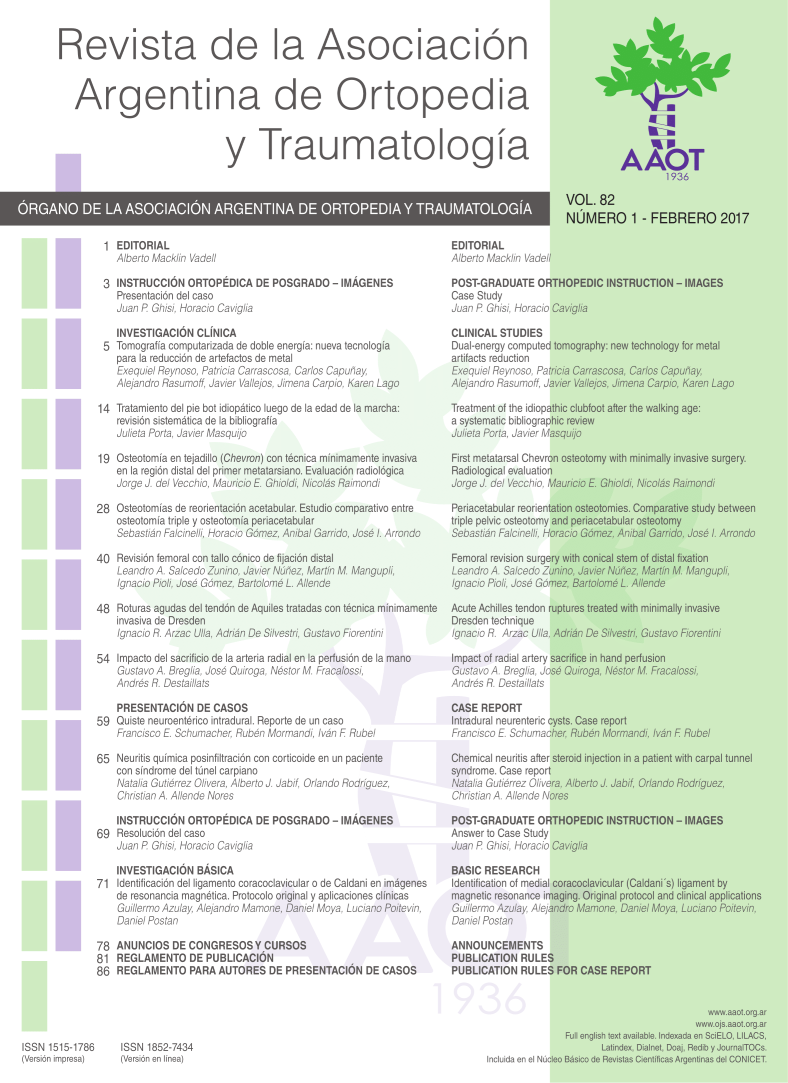Dual Energy Computed Tomography: New technology for metal artifacts reduction
Main Article Content
Abstract
Downloads
Metrics
Article Details

This work is licensed under a Creative Commons Attribution-NonCommercial-ShareAlike 4.0 International License.
Manuscript acceptance by the Journal implies the simultaneous non-submission to any other journal or publishing house. The RAAOT is under the Licencia Creative Commnos Atribución-NoComercial-Compartir Obras Derivadas Igual 4.0 Internacional (CC-BY-NC.SA 4.0) (http://creativecommons.org/licences/by-nc-sa/4.0/deed.es). Articles can be shared, copied, distributed, modified, altered, transformed into a derivative work, executed and publicly communicated, provided a) the authors and the original publication (Journal, Publisher and URL) are mentioned, b) they are not used for commercial purposes, c) the same terms of the license are maintained.
In the event that the manuscript is approved for its next publication, the authors retain the copyright and will assign to the journal the rights of publication, edition, reproduction, distribution, exhibition and communication at a national and international level in the different databases. data, repositories and portals.
It is hereby stated that the mentioned manuscript has not been published and that it is not being printed in any other national or foreign journal.
The authors hereby accept the necessary modifications, suggested by the reviewers, in order to adapt the manuscript to the style and publication rules of this Journal.
References
2. Matsumoto K, Jinzaki M, Tanami Y, Ueno A, Yamada M, Kuribayashi S. Virtual monochromatic spectral imaging with fast kilovoltage switching: Improved image quality as compared with that obtained with conventional 120-kvp ct. Radiology. 2011;259:257-262
3. Bamberg F, Dierks A, Nikolaou K, Reiser MF, Becker CR, Johnson TR. Metal artifact reduction by dual energy computed tomography using monoenergetic extrapolation. European radiology. 2011;21:1424-1429
4. Pessis E, Campagna R, Sverzut JM, Bach F, Rodallec M, Guerini H, Feydy A, Drape JL. Virtual monochromatic spectral imaging with fast kilovoltage switching: Reduction of metal artifacts at ct. Radiographics : a review publication of the Radiological Society of North America, Inc. 2013;33:573-583
5. Mangold S, Gatidis S, Luz O, Konig B, Schabel C, Bongers MN, Flohr TG, Claussen CD, Thomas C. Single-source dual-energy computed tomography: Use of monoenergetic extrapolation for a reduction of metal artifacts. Investigative radiology. 2014;49:788-793
6. Wang Y, Qian B, Li B, Qin G, Zhou Z, Qiu Y, Sun X, Zhu B. Metal artifacts reduction using monochromatic images from spectral ct: Evaluation of pedicle screws in patients with scoliosis. European journal of radiology. 2013;82:e360-366
7. Meinel FG, Bischoff B, Zhang Q, Bamberg F, Reiser MF, Johnson TR. Metal artifact reduction by dual-energy computed tomography using energetic extrapolation: A systematically
optimized protocol. Investigative radiology. 2012;47:406-414
8. Nakamoto A, Kim T, Hori M, Onishi H, Tsuboyama T, Sakane M, Tatsumi M, Tomiyama N. Clinical evaluation of image quality and radiation dose reduction in upper abdominal computed tomography using model-based iterative reconstruction; comparison with filtered back projection and adaptive statistical iterative reconstruction. European journal of radiology. 2015;84:1715-1723
9. Morsbach F, Bickelhaupt S, Wanner GA, Krauss A, Schmidt B, Alkadhi H. Reduction of metal artifacts from hip prostheses on ct images of the pelvis: Value of iterative reconstructions. Radiology. 2013;268:237-244
10. Zhu Z, Zhao XM, Zhao YF, Wang XY, Zhou CW. Feasibility study of using gemstone spectral imaging (gsi) and adaptive statistical iterative reconstruction (asir) for reducing radiation and iodine contrast dose in abdominal ct patients with high bmi values. PloS one. 2015;10:e0129201
11. Han SC, Chung YE, Lee YH, Park KK, Kim MJ, Kim KW. Metal artifact reduction software used with abdominopelvic dual-energy ct of patients with metal hip prostheses: Assessment of image quality and clinical feasibility. AJR. American journal of roentgenology. 2014;203:788.
12. Schwahofer A, Bar E, Kuchenbecker S, Grossmann JG, Kachelriess M, Sterzing F. The application of metal artifact reduction (mar) in ct scans for radiation oncology by monoenergetic extrapolation with a dect scanner. Zeitschrift fur medizinische Physik. 2015
13. Jia Y, Zhang J, Fan J, Li C, Sun Y, Li D, Xiao X. Gemstone spectral imaging reduced artifacts from metal coils or clips after treatment of cerebral aneurysms: A retrospective study of 35 patients. The British journal of radiology. 2015:20150222
14. Lee YH, Park KK, Song HT, Kim S, Suh JS. Metal artefact reduction in gemstone spectral imaging dual-energy ct with and without metal artefact reduction software. European radiology. 2012;22:1331-1340
15. Lewis M, Reid K, Toms AP. Reducing the effects of metal artefact using high kev monoenergetic reconstruction of dual energy ct (dect) in hip replacements. Skeletal radiology. 2013;42:275-282
16. European guidelines on quality criteria for computed tomography. Available at: Http://www.Drs.Dk/guidelines/ct/quality/index.Htm. Accessed august 2015.
17. Guggenberger R, Winklhofer S, Osterhoff G, Wanner GA, Fortunati M, Andreisek G, Alkadhi H, Stolzmann P. Metallic artefact reduction with monoenergetic dual-energy ct: Systematic ex vivo evaluation of posterior spinal fusion implants from various vendors and different spine levels. European radiology. 2012;22:2357-2364
18. Schneider D, Apfaltrer P, Sudarski S, Nance JW, Jr., Haubenreisser H, Fink C, Schoenberg SO, Henzler T. Optimization of kiloelectron volt settings in cerebral and cervical dual-energy ct angiography determined with virtual monoenergetic imaging. Academic radiology. 2014;21:431-436
19. Liu PT, Pavlicek WP, Peter MB, Spangehl MJ, Roberts CC, Paden RG. Metal artifact reduction image reconstruction algorithm for ct of implanted metal orthopedic devices: A work in progress. Skeletal radiology. 2009;38:797-802

